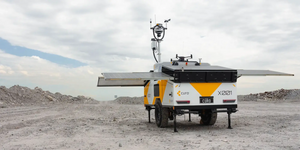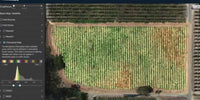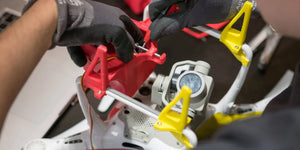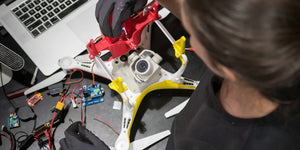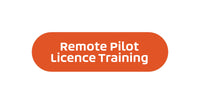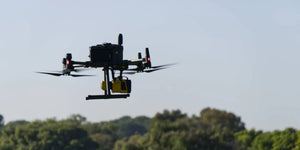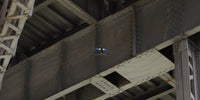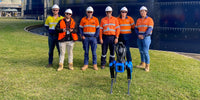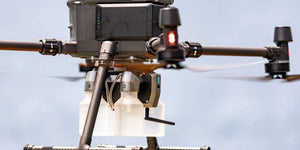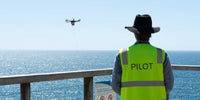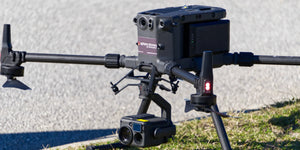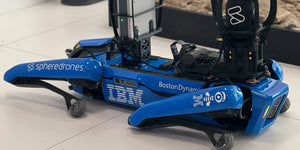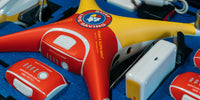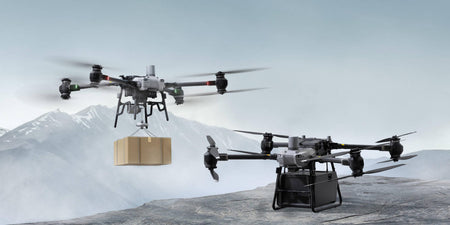The Matrice 300 RTK platform is designed with extensive system and sensor redundancies to maximise flight safety and reliability. These redundancies and safety mechanisms include dual flight control system sensors, dual control signal links, dual intelligent batteries, dual transmission links, obstacle sensor system redundancies, and three-propeller emergency landing.
Flight Control Sensor Redundancy
Dual Inertial Measurement Units
An inertial measurement unit (IMU) measures the aircraft’s real-time three-axis acceleration and angular velocity, and helps calculate the aircraft’s velocity, position, and attitude angle. The M300 RTK is designed with an industrial-grade IMU redundancy, in addition to fault diagnostics mechanisms and redundancy switching algorithms. In the unlikely case that the main IMU fails, the backup IMU will activate within two hundred milliseconds to maintain flight safety and reliability.
Dual Barometers
A barometer determines relative altitude based on atmospheric pressure and provides precise altitude readings for the aircraft. The M300 RTK’s dual barometer redundancy design allows the drone to switch to the backup barometer if the primary one fails, ensuring flight stability and aircraft reliability.
Dual RTK Antennas + GNSS Module
The Real Time Kinematic (RTK) system is a positioning system that generates aerial data including latitude, longitude, and altitude readings for the drone’s flight control system. These data allow the aircraft to perform actions such as flying with manual commands through the remote controller, following an automated flight path, or hovering steadily and precisely. The RTK system is also capable of writing centimeter-level accurate metadata in the images taken, which meets the high accuracy requirements of the surveying and mapping industry.
In addition to maintaining the drone’s heading, the dual RTK antennas also back up the compasses so that the drone can safely and stably navigate complex environments with electromagnetic interference, such as near power lines or metallic structures. The M300 RTK’s GNSS module supports GPS, GLONASS, Beidou, and Galileo satellite positioning systems, and is also backed up by the dual RTK antennas, providing the aircraft with accurate positioning capabilities wherever the mission takes place.
Dual Compasses
A compass provides heading information for the drone. The M300 RTK has two compasses to ensure that it continues on the right course even if one of the compasses fails. Meanwhile, the compasses are backed up by the two antennas in the RTK modules, so that in the case where the RTK modules are blocked, the compasses can still help the drone maintain course.
Six Pairs of Vision Sensors
The vision sensor pairs provide binocular machine vision, which senses changes in the aircraft’s position and attitude, visually positioning the aircraft while helping it sense obstacles. If one or more of the sensor pairs are down, the ToF sensors and the remaining vision sensors can still keep the drone functioning safely.
Obstacle Sensing Range:
- Forward / Backward / Left / Right: 0.7 - 40 m
- Upward / Downward: 0.6 - 30 m
Six Infrared ToF Sensors
Infrared ToF sensors resolve the distance to an object using time-of-flight techniques, measuring the round-trip time of an infrared light signal. The M300 RTK is equipped with ToF sensors that provide real-time information on the surroundings of all six sides of the aircraft. When operated at night or in lowlight conditions, and if the vision system is out of commission, the drone can still rely on the ToF sensors to maintain obstacle sensing abilities.
Obstacle Sensing Range: 0.1 - 8 m FOV 30°
The vision and ToF sensor systems back each other up in all 6 directions, so that even if the vision system is unavailable in dark places, the ToF sensors can provide the drone with enough information to steer clear of obstacles.
Auxiliary Lights
The 60 Hz auxiliary lights on the top and bottom of the aircraft have a 5-meter effective distance. When enabled, they will be turned on automatically in suboptimal lighting conditions so that the vision sensor system can continue working.
Control Signal Redundancy
Pulse width modulation (PWM) signals are used by default for communication between the flight control system and the Electric Speed Controller system. In the highly unlikely case that they become unavailable, the universal asynchronous receiver-transmitter (UART) communication link will take over to keep the critical control signals stable and secure.
Dual Intelligent Batteries
The M300 RTK is powered by two batteries, each with a capacity of 5,935 mAh, a voltage of 52.8 V, and a maximum charging power of 470 W. They ensure that even if there are issues with one battery during flight, the other one can help the aircraft return and land safely.
Dual Transmission Links
The M300 RTK’s two antennas ensure that if one is down, the other one can jump right in to continue transmitting. Meanwhile, both the 2.400 to 2.4835 GHz and the 5.725 to 5.850 GHz bands are supported, so in high-interference environments where one band becomes unavailable, the drone will automatically switch to the other band.
Dual Remote Controller Mode
The dual remote controller mode of the M300 RTK allows each of the two operators to take over control of the aircraft and payloads quickly in the case where communication is lost between the RC and the drone. Operations can continue seamlessly without compromising flight safety.
Additional System Designs to Maximise Safety and Reliability
Three-propeller Emergency Landing
In the unlikely case of a motor malfunction during flight, the M300 RTK can make an emergency landing with just three propellers/motors. Basic controls, such as ascending, descending, and horizontal movements, are still in place. Inevitably, the drone and the payload will be damaged during the landing, but the operator can choose to land somewhere away from people or buildings to keep them safe.
Extra-wide FPV Camera
The FPV camera has a 145° FOV and delivers a live feed at 960p. Even if the main payload camera is not working, the FPV camera still allows the pilot to maintain sufficient situational awareness to safely land the drone.
ADS-B Receiver
The M300 RTK is equipped with DJI AirSense, a technology that enhances airspace safety by providing the operator with real-time information about airplanes and helicopters within 20 km, including their position, altitude, heading, and velocity. The risk of a close encounter with another aircraft is sent to the pilot in real-time in the DJI Pilot app, so informed decisions can be made quickly to ensure safety.
Source: DJI
